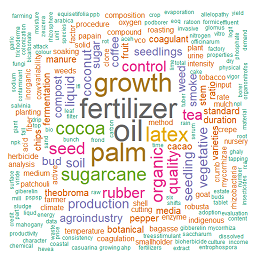Kajian Kitosan Sebagai Agens Pengendali Penyakit Busuk Buah Kakao (Phytophthora megakarya L.)
DOI:
https://doi.org/10.25181/jaip.v6i2.977Abstract
Indonesia is a cocoa producing country with production of 425 thousand tons per year. However, production continues to decline, among others, caused by Phytopthora megakarya cause of fruit rot disease of cocoa, therefore it is necessary effective control of cacao fruit rot disease. This study aims to determine the effect of chitosan concentration on the growth of P. megakarya cause of fruit rot disease in vitro. The research was conducted at Plant Disease Laboratory, Department of Agrotechnology, Faculty of Agriculture, University of Lampung, from November 2012 to January 2013. V8 media research as a medium of growing P. megakarya. The workshops are arranged in a complete randomized design (CRD) consisting of (1) V8 media without chitosan (2) V8 media 0,2%, (3) V8 media 0,4%, (4) V8 media 0,6%, (5) ) V8 media 0,8% (6) medium V8 fungicided copper oxide 56%, and replicated six times. The results showed that the colonies growth of P. megakarya 6 days after incubation in V8 media 0,4%, 0,6%, 0,8% more depressed than growth on the V8 without chitosan media.  Keywords: concentration, disease control, in vitro, V8 mediaDownloads
References
Adedeji, A. R., Odebode, A. C., & Agbeniyi, S. O. (2008). Bioassay of five trichoderma strains against Phytophthora megakarya (Cacao pod-rot) in Nigeria. Scientific Research and Essays, 3(9), 390-394.
Badawy, M. E., & Rabea, E. I. (2011). A biopolymer chitosan and its derivatives as promising antimicrobial agents against plant pathogens and their applications in crop protection. International Journal of Carbohydrate Chemistry, 2011, 1-30.
Duniway, J. M. (1983). Role of physical factors in the development of Phytophthora diseases. In D. C. Erwin, S. Bartnicki-Garcia, & P. H. Tsao (Eds.), Phytophthora: Its Biology, Taxonomy, Ecology, and Pathology (pp. 175-187). Minnesota: The American Phytopathological Society.
Gotama, C. (2011). Kemampuan Kitosan Sebagai Pengendali Jamur Phytophthora palmivora L. Penyebab Penyakit Busuk Buah Kakao (Theobroma cacao L.) Secara In Vitro. Unpublished undergraduate thesis, Universitas Lampung, Bandar Lampung.
Lestari, P., & Purnomo, P. (2018). Intensitas Serangan Hama Penggerek Batang Kakao di Perkebunan Rakyat Cipadang, Gedongtataan, Pesawaran. Jurnal Agro Industri Perkebunan, 6(1), 1-8.
Nene, Y. L. (1971). Fungicide in Plant Disease Control. New Delhi: Oxford & IBH Publishing Co.
Prameswita, W., Ismono, R. H., & Viantimala, B. (2014). Faktor-Faktor yang Mempengaruhi Volume Ekspor Kakao Provinsi Lampung. Jurnal Ilmu-Ilmu Agribisnis, 2(1), 1-7.
Prasetyaningrum, A., Rokhati, N., & Purwintasari, S. (2007). Optimasi derajat deasetilasi pada proses pembuatan chitosan dan pengaruhnya sebagai pengawet pangan. Jurnal Riset dan Iptek, 1, 39-46.
Ramlan. (2010). Pengelolaan penyakit busuk buah kakao. In: Prosiding Seminar Ilmiah dan Pertemuan Tahunan PEI dan PFI XX Komisariat Daerah Sulawesi Selatan. pp. 380—387.
Semangun, H. (1996). Penyakit-Penyakit Tanaman Perkebunan di Indonesia. Yogyakarta: Gadjah Mada University Press.
Simpson, B. K., Gagne, N., Ashie, I. N. A., & Noroozi, E. (1997). Utilization of chitosan for preservation of raw shrimp (Pandalus borealis). Food Biotechnology, 11(1), 25-44.
Downloads
Published
How to Cite
Issue
Section
License
Authors who publish with Jurnal Agro Industri Perkebunan agree to the following terms:
Authors retain copyright and grant the Jurnal Agro Industri Perkebunan right of first publication with the work simultaneously licensed under a Creative Commons Attribution License (CC BY-SA 4.0) that allows others to share (copy and redistribute the material in any medium or format) and adapt (remix, transform, and build upon the material for any purpose, even commercially) with an acknowledgment of the work's authorship and initial publication in Jurnal Agro Industri Perkebunan.
Authors are able to enter into separate, additional contractual arrangements for the non-exclusive distribution of the journal's published version of the work (e.g., post it to an institutional repository or publish it in a book), with an acknowledgment of its initial publication in Jurnal Agro Industri Perkebunan. Authors are permitted and encouraged to post their work online (e.g., in institutional repositories or on their website) prior to and during the submission process, as it can lead to productive exchanges, as well as earlier and greater citation of published work.


























